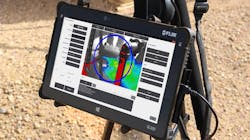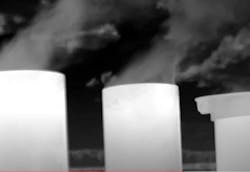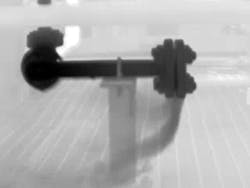How optical gas imaging can help meet the challenge of corporate environmental responsibility
A hot topic in the processing industries — especially the oil and gas sector — is the concept of environmental, social and corporate governance (ESG) — a set of guidelines that describes responsible corporate operations driven by societal expectations, markets and other factors. In fact, a recent Bloomberg study of quarterly earnings and other related financial conference calls concerning the companies that comprise the S&P 500 Energy Index showed that mentions of ESG and other sustainability-related terms soared in the first quarter of 2021 versus the same period in 2020. More specifically, the use of ESG-related terms among oil and gas companies jumped more than 700% year over year.
For industrial processing concerns, ESG can serve as a vital framework to help govern an organizations’ greenhouse gas (GHG) and other noxious gas emissions. ESG tackles energy use, pollution output, a company’s relationship with suppliers, its overall impact on the body politic and organizational ethics. This can range from the ability to identify and mitigate potentially dangerous ammonia leaks in a food processing facility to the before-mentioned gas industry and the ability to identify and mitigate fugitive methane and other hydrocarbon emissions known to contribute to climate change.
Often, ESG serves as a component of an organization’s broader corporate social responsibility (CSR) program, designed to positively influence key stakeholder perception. Among those key stakeholders demanding a greater focus on ESG are investors. According to MorningStar, flows into sustainable open-end and exchange-traded funds available to U.S. investors reached $51.1 billion, more than double the increase in 2019, and a nearly tenfold increase above 2018, when flows reached a then-record $5.4 billion. As investor demand and fund allocation increasingly focuses on ESG, organizations must not only keep up with, but stay ahead of, those demands by not only telling stakeholders of their ESG strategy, but also showing progress on their respective initiatives.
After all, investors want to strategically avoid certain risks that can hamper future returns, and industrial contributions to climate change poses a significant public relations and overall business risk as governments, environmental groups and even community awareness across the globe continue to apply both regulatory, political, and social pressure for change.
Combating GHG emissions
Chief among investor environmental concerns is climate change, including effective methane emissions mitigation in related industries. According to a recent report released by the Global Methane Assessment from the Climate and Clean Air Coalition (CCAC) and the United Nations Environment Programme (UNEP), cutting global methane emissions by 40-45% would prevent up to 0.3 degrees Celsius of climate warming.
With such high environmental risks and impacts, let alone changing investor sentiment, oil and gas producers and other industrial processors that produce or require the use of noxious gasses, must take action now to demonstrate efforts to track, manage and limit both leak and vent emission sources. When an organization discovers and documents all its leaks and vents, it can then report on its environmental footprint and, more importantly, show progress to key stakeholders. Here, quantifiable optical gas imaging (qOGI), or the ability to visualize and measure leak and vent gas emissions, can play a crucial role in achieving those objectives more accurately.
OGI vs qOGI
OGI cameras allow for safe and quick visualization of otherwise invisible gas leaks through spectrally filtered thermal cameras. Each gas has its own spectral absorption characteristics, and many will absorb some infrared energy in a certain narrow range of wavelengths. Thus, by matching the spectral filter with the unique absorption of specific gases, OGI cameras can visualize where a gas plume exists, by blocking the energy from reaching the IR detector.
Compared to toxic vapor analyzers (TVA), or sniffers as they are called in the field, OGI devices are one of the most effective and efficient emissions reduction tools and are even considered the best system of emissions reduction (BSER) by the U.S. Environmental Protection Agency (EPA) in the 40 CFR, Part 60 Subpart OOOOa regulations, colloquially referred to as “quad-oh-eh.” They allow operators to see small concentrations of gas emissions, in addition to large leaks, from safe distances whereas a TVA is only able to detect gas by physically placing a probe directly on a leaking equipment’s component, often putting the operator in the gas plume.
Meanwhile, qOGI camera systems have proven the ability to not only visualize and detect, but to quantify hydrocarbon and volatile organic compound (VOC) leaks in units of mass leak rate, volumetric leak rate or concentration. This adds a whole new aspect to ESG guidelines and reporting where organizations now have the ability to detect and quantify not only what is leaking and how much, but where the leak is coming from so the faulty component can be repaired.
When compared to the Bacharach Hi Flow® Sampler (BHFS) by a Canadian Oil and Gas industry field test, qOGI achieved +/- 18% accuracy over several weeks of testing, comprising of more than 100 test points across a variety of environmental conditions and backgrounds. Furthermore, a European industry research organization — with memberships from the majority of European oil companies — conducted a study and concluded that qOGI significantly outperforms in terms of result accuracy when compared to the U.S. EPA Method 21 approved technology, or TVA, by approximately six times.
As regulatory bodies catch up to the promise of qOGI, forward-looking organizations will be quick to recognize the value of the technology to appease key stakeholders, including the ability to drive investment interest that can potentially outweigh the added costs of creating and managing a comprehensive leak detection and repair (LDAR) program.
Tracking and reporting emissions
Often, emission mitigation metrics are set at the C-level and other executive levels commonly found in boardrooms, but critical details tied to detection such as valve, flange, and connection leaks and quantification of GHG emissions are tied to what is occurring on the ground. Thus, the qOGI camera solution is the optimal tool to create a boots-on-the-ground program that shows us what is leaking and venting down to the literal nuts and bolts within the facility level, and provide data that can then map up to and create more accurate mitigation metrics to be set at the corporate level.
Gas emitting from such sources as threaded connections, thief hatches, pressure relief valves, and malfunctioning equipment like flares and vapor recovery systems require LDAR tools like OGI cameras and qOGI. However, an effective LDAR program also requires organizations to repair those detected leaks, adding additional time and labor costs on top of the need to train up staff and maintain OGI related equipment. However, the calculus for those costs are changing due to shifting investor sentiment and broader political and societal pressures.
While vents and other engineered sources of release are increasingly being phased out of the process, similarly to how we no longer use lead paint or mercury thermometers, there are still many components that would benefit from a better understanding of the leak quantity. If a component is allowed to leak at a maximum leak rate of six standard cubic feet per hour (scfh), using qOGI technology to understand and quantify the leak size would be ideal to have in-field knowledge of the situation, and possibly avoid regulatory fines or having the facility shut down.
According to a report from the U.S. EPA, the United States oil and gas industry loses an estimated 1.4 to 2.3 percent of natural gas from operations due to leaks, representing a relatively easy step for organizations downstream, midstream, and upstream to show quantifiable progress as part of a broader ESG program. Through qOGI technology, regulators, organizations, and investors can gauge more accurately how fugitive gas emissions add to the carbon footprint these companies maintain, empowering them to make more informed investment and regulatory decisions, respectively. Those organizations that can definitively show progress will be better positioned to take an increasingly larger share of the rapidly growing interest in ESG investing.
The larger picture
The oil, gas and coal industries aren’t the only contributors to gas emissions, and methane isn’t the only GHG of concern. The specter of ammonia leaks within the food and beverage processing industry tied to refrigeration applications; landfills releasing methane, carbon dioxide and other GHGs; sulfur hexafluoride leaks in the utility industry; and the plastics industry emitting ethylene as part of production, all pose significant challenges. When combating GHGs, embracing technology like qOGI empowers organizations to improve accuracy in GHG/ESG reporting across many industries.
Meanwhile, climate change consensus continues to build momentum, and it is increasingly likely that investors and governments alike will further demand steps and regulations to combat and potentially reverse the threat of a rapidly changing climate.
Ultimately, OGI and qOGI solutions are part of the sustainable future of the oil and gas industry, in addition to other processing industries that must contend with the growing power of investor and citizen activism. If organizations wish to remain relevant, fully operating, and profitable in the years ahead, it is imperative to adopt sustainable practices, and investments in equipment like OGI and qOGI can help achieve those goals.
Craig R. O’Neill has worked for FLIR since 2002 and been actively involved in the OGI market since the introduction of commercial Optical Gas Imagers in June 2005. Currently, he has global responsibility for the Optical Gas Imaging line of business and the strategy for FLIR’s solutions in the oil and gas industry. In this role, he is the linking piece between customers, industry stakeholders, strategic partners, and many vertically integrated aspects of the FLIR Instruments division, including sales, marketing, engineering, and product management. His goal is to ensure FLIR’s alignment to provide sensing solutions that meet the needs of the oil and gas industry.


